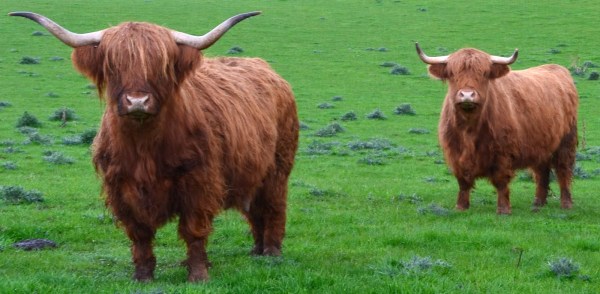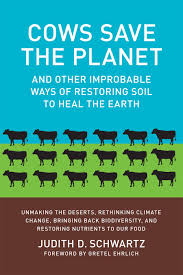This book suggests that increasing livestock numbers might help soils to store carbon and so help to tackle climate change. This is a controversial hypothesis. My review of the book is below this pictures of some wee sleekit, cowrin’ timorous beasties!

Cows Save the Planet – Judith Schwartz
Judith Schwartz is an American journalist whose main interest is in alternative economics rather than soil science, and this shows in the book, both in the focus on American prairie agriculture and in some of the flaws in the science.
The book is aimed at a general audience, and aims to use a light touch with the science while keeping the reader engaged with a human interest angle on the people who the author meets. This works reasonably well, although the lack of numbers and references is frustrating, and at times made me suspicious about some of the assertions. For example I tried to trace a study on the nutrient content of food from the UK Ministry of Health (sic) and could not locate it. Similarly the book refers to the numerous papers published by Australian soil campaigner Christine Jones, but none of these were from peer reviewed journals. That said it does make some interesting points about how we manage agricultural soils.
The main thesis of the book is that by storing more carbon in soils we can improve soil fertility, reduce the need for agrochemicals and retain water in soils setting up a virtuous circle which captures carbon and combats climate change. Certainly soil carbon is an important element of the carbon cycle, and soil carbon stocks should be maintained and where possible enhanced.
The cows referred to in the book’s title are supposed to save the planet by adding manure and breaking up impervious, dry clay surfaces increasing rainwater infiltration which in turn promotes plant growth which returns more carbon to the soil. However the numbers to back this up aren’t presented, so while there is anecdotal evidence that changes to grazing management and increased stocking levels might be beneficial for some degraded soils in hot dry regions with mineral soils the applicability of this to organic or organo-mineral UK soils which are cool and wet is less clear. On UK soils there is a risk of compaction, erosion and loss of soil structure where high stocking levels lead to over-grazing. The author almost completely ignores the effect which increased nitrogen inputs from manure and urine could have on nitrous oxide emissions and nitrate run-off as well as dismissing the increase in methane emissions which would occur from increased ruminant numbers.
At times Schwartz seems convinced that climate change can be tackled by increasing soil carbon stocks alone. However limits on the capacity of soils to increase carbon stocks are not considered. While soils can undoubtedly make a contribution to removing carbon dioxide from the atmosphere, at times the book strays close to climate denial suggesting that no other action is necessary and that we can continue with business as usual use of fossil fuels and expect soils to mop up all of the carbon dioxide released with no need for lifestyle and technological change.
Schwartz blames the agrochemical industry for soil degradation. It is certainly true that agricultural intensification has caused problems for soils. While efforts to remedy this have focussed on supplementing major plant nutrients by adding synthetic fertilisers less attention has been given to trace nutrients and soil carbon. Another cause of soil degradation which gets less attention in the book is the transposition of European agricultural practices to parts of the world for which they were not developed for. Ploughing the prairies caused enormous damage to soils long before the advent of modern agrochemicals. We should recognise the diversity of global soils and be wary of treating imported soil management practices such as tillage reduction, use of cover crops, mob grazing or biochar addition as “magic bullets”.
The final chapter takes a look at economic context of soil management. Here Schwartz’s economics background comes to the fore, pointing out that economic growth has to be constrained by the ability of environmental resources to support it. She also discusses the economic benefits of managing soil well so that inputs of fertilisers and pesticides can be reduced, and how we could better value the contributions which soils make to the economy.
I came away from this book with mixed feelings about it. There are some flaws in it’s analysis, however it does make the case for better management of soils and for more value to be given to the services they provide, and that has to be a good thing.
